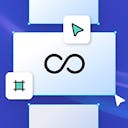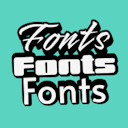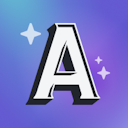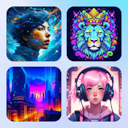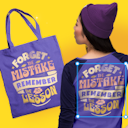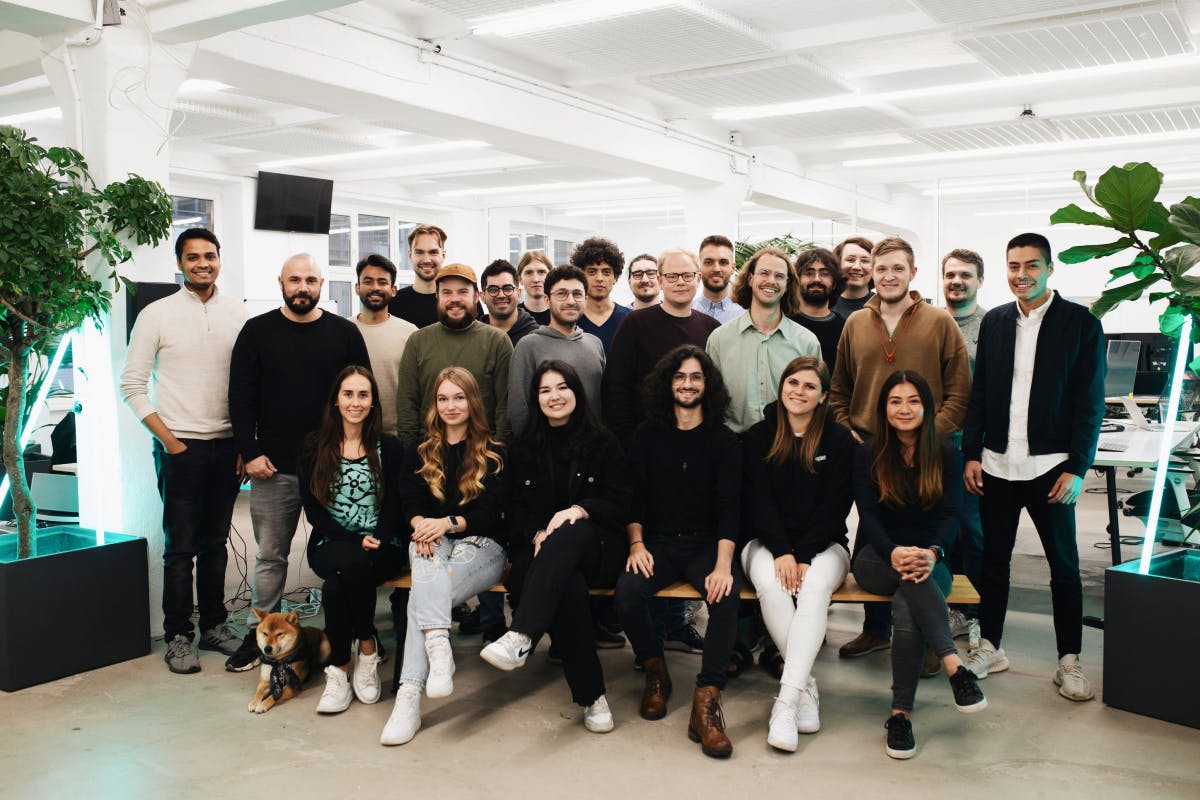Product
Templates
Resources
Company
Home
Blog
Design
75 Retro Fonts: From '50s to '90s
75 Retro Fonts: From '50s to '90s

You can rarely ever go wrong by using retro fonts. Whether it's the bold, funky vibe of the '70s or the neon-infused coolness of the '80s, retro fonts bring a touch of nostalgia that modern audiences love.
At Kittl, we’re all about fonts. With our expertise in the world of fonts and typography, we've curated a collection of stunning retro fonts that you can use for free! Whether you're crafting a logo, designing a poster, or just playing around with some creative ideas, this list is here bring a vintage touch to your projects.
In this list, you’ll find styles spanning the time of the mid-century modern ‘50s aesthetic to the grunge aesthetic of the 90s. Let’s explore what retro fonts are all about and how you can start using them today!
Access all 75 retro fonts, here, in a pre-made Kittl project.
Table of contents
What is retro?
The term retro is often used synonymously with vintage but the two terms are entirely different. “Retro" generally refers to styles, aesthetics, and cultural elements that are inspired by or replicate those of the late 20th century (specifically the 1950s through the 1990s). So essentially, something “retro” is newly made or somewhat new (within 20 years old). But it’s designed to look as if it belongs in an older time.
One designer quoted in Southern Living described retro as "anything 20 years old, but not yet 40 years old." Another believes anything can be considered retro if it reminds you of your past.
Vintage on the other hand, is something that is actually old - not just inspired by it. The Spruce describes vintage as anything between 20 and 99 years old. Anything older is considered antique.

What are characteristics of retro fonts?
Now that we understand what counts as “retro” and the differences of retro vs vintage, let’s look at the key characteristics of retro fonts. Here's a breakdown of what "retro" fonts commonly include based on eras:
- 1950s: This era is associated with mid-century modern design, characterized by clean lines, organic shapes, and vibrant colors. In typography, this might include bold, sans-serif fonts, script fonts, and geometric forms. It also includes the bright and theatrical style associated with classic '50s American diners. Think bold checkerboard patterns, bright reds, pastels, and chrome accents.
- 1960s: The 60s were a time of bold experimentation, heavily influenced by the counterculture movement. Pop Art emerged during this period, which was a rebellious, stark contrast to the traditionalist '50s style. Design from the '60s often features psychedelic influences, with fluid, swirling shapes and bright, contrasting colors. Fonts from this decade might include decorative typefaces with a hand-drawn feel, reflecting the vibrant and rebellious spirit of the time. The Art Deco style made a comeback during this period, often appearing in the fonts used on album covers and film posters of the time.
- 1970s: The 70s built on the experimental spirit of the 60s but brought in a more laid-back, earthy vibe. This decade is known for groovy fonts with rounded edges, bubble letters, and bold, curvy typography. The color palette often included warm, earthy tones like browns, oranges, and yellows, mirroring the natural and relaxed aesthetic of the time. Art Deco influences emerged again near the middle of this decade with the popularity of The Great Gatsby film.
- 1980s: The '80s is when popular design and style shifted heavily. This period is often remembered for its neon colors, futuristic themes, and digital influences. This includes bold, angular fonts, often seen in video game designs and early computer interfaces. The aesthetic was heavily influenced by pop culture, including movies, music, and fashion.
- 1990s: The 90s were more eclectic, drawing from a mix of grunge, early internet culture, and minimalism. Retro fonts from this era might include distressed or "grunge" typefaces, pixelated fonts, or early digital-inspired designs.
Beyond retro bonus: old school fonts
Vintage Fonts: As we said above, vintage is different than retro, but we’d still be remiss to not mention the characteristics of vintage fonts here. You’ll find vintage fonts are often detailed and ornate, reminiscent of the typographic styles used in the late 19th and early 20th centuries.
They typically feature serif-heavy letterforms, intricate flourishes, and a weathered, textured appearance that conveys an aged, timeless quality. These fonts are commonly used in designs aiming to capture the essence of a bygone era, such as antique packaging, old advertisements, and classic book covers.
Watch the video below to learn about 5 popular vintage fonts you can use for free in Kittl!
Why are retro fonts popular today?
It shouldn't be a surprise that retro fonts have made a comeback in modern design. By the beginning of 2024, the search volume for the term “retro style” basically doubled, surging from a monthly 6k average to around 14k. And it’s projected to continue growing.
As designers and brands look to create a sense of nostalgia in their work while still feeling contemporary, retro fonts offer the perfect blend of the old and the new. They bring a certain warmth and familiarity that resonates with audiences, reminding them of past eras while still feeling relevant in the modern world. With their bold, playful, and often quirky characteristics, these fonts are not just about looking back to the past - they’re about reviving the past.
Take the popular Netflix series Stranger Things, for instance. Its use of the 1977 ITC Benguiat font in the title sequence has become iconic, not just for its retro vibe but for how perfectly it sets the tone for the show’s 1980s setting. This revival of a classic font has inspired countless designs across branding and digital media, proving that what was once considered old-fashioned can become trendy again when recontextualized.
Other examples include the resurgence of 80s and 90s fonts in everything from fashion branding to social media graphics, reflecting a broader cultural trend where nostalgia meets modern innovation. Whether it’s for a vintage logo or a throwback marketing campaign, retro fonts are the go-to for designers looking to connect the past with the present in a visually compelling way.
What are some retro fonts you can use for free in Kittl?
1950s style fonts
The 1950s ushered in the mid-century modern aesthetic, a design movement that's still celebrated today. Typography from this era mirrors the sleek, streamlined feel of the time. You’ll find bold sans-serif fonts with clean, geometric forms that reflect the optimism of the post-war boom. Think about the playful, yet polished look of diner signs and vintage advertisements. Script fonts were also popular, often featuring elegant, flowing lines that added a touch of sophistication to everything from car logos to movie posters. These fonts capture the essence of a decade characterized by its forward-thinking spirit and polished style.
Here are just a few of the ‘50s style fonts you can find in Kittl:
- Egyptienne E - A bold retro font choice in a Western style design. This one is a great choice to replicate the vintage Western style you see in old American Western shows.
- Bellefair - A balanced and classy font with smooth, round lines that showcases a flair of sophistication.
- Midflite - A sophisticated font that’s reminiscent of the famous “Vogue” font with a flare of fun.
- Belanosima - This simple font offers a clean appearance with a condensed structure, following the streamlined designs of the ’50s.
- Adventurer 01 - A warm and rustic font that mirrors the classic style you’ll find on a 1950’s poster or diner sign.
- Adventurer 02 - This font is from the same family as Adventurer 02 as the name would suggest. This particular font is more structured than its predecessor, perfect for a bolder look.
- Adventurer 07 - A playful yet refined font that draws inspiration from vintage travel posters, bringing an adventurous spirit to your designs with its bold, stylish letterforms.
- Amy Riyas - A chic font with a vintage feel that combines elegance with a contemporary twist. This typography style is perfect for upscale branding or editorial layouts.
- Font Diner Swanky - A retro-inspired font that captures the mid-century charm of 1950s diners, complete with quirky, fun letterforms that add a touch of nostalgia to your projects.
- Sacramento - A graceful, cursive font with delicate strokes that offer a handwritten feel. You’ll often find this style elegantly scrawled on ‘50s album covers. So if you’re looking to create a ‘50s retro album cover, this is the perfect font to replicate the real thing.
- Risque - A bold and playful font with exaggerated, whimsical shapes that brings a sense of fun to designs. You can easily imagine this font displayed on a ‘50s diner menu, film cover, or playful vintage logo design.
- Agbalumo - A contemporary font with bold, angular shapes that reflect a modern yet artistic aesthetic, great for making a strong, creative statement. This is another style that was common on album covers or film posters.
- Courier Prime - This typewriter-style font is a take on the 1956 font, IBM's Courier, designed by Howard Kettler. It offers an authentic vintage look that’s the perfect addition to retro designs.
- Tangerine - A graceful, flowing script font that captures the elegance of vintage calligraphy. It’s perfect for adding a timeless touch to your projects. You may notice it’s reminiscent of the classic "The End" titles that appeared at the close of 1950s films.
- Bigelow Rules - A quirky and bold typeface with exaggerated curves and playful details. This font is an excellent choice for eye-catching poster designs and will perfectly capture the time period.
1960s style fonts
The 1960s were all about breaking the mold, and the fonts from this era are no exception. Influenced by the counterculture and psychedelic movements, typefaces from the 60s are known for their bold experimentation. Imagine swirling, fluid letterforms that seem to dance on the page, often infused with bright, contrasting colors. Decorative fonts with a hand-drawn feel were in vogue, reflecting the vibrant and rebellious energy of the time. Whether it’s the groovy aesthetics of a psychedelic rock poster or the playful vibe of a mod-inspired advertisement, 60s fonts bring a sense of artistic freedom and bold creativity.
Here are just a few of the ‘60s style fonts you can find in Kittl:
- Aerillyo - A free-spirited retro font with flowing, hand-drawn letterforms that perfectly encapsulate the psychedelic vibe of the 1960s. Ideal for designs that want to channel the carefree, artistic energy of the era.
- Lazenby Computer - This font is a recreation of the typeface, Moore Computer, designed by James H. Moore in 1968. This retro font is ideal for any tech-inspired or futuristic designs that want to retain a vintage feel.
- Pilowlava - This geometric font lies on the shoulders of research conducted by Swiss designer Armin Hofmann in his Graphic Design Manual edited in 1965. With its bold, inflated forms, it’s the perfect font choice to bring the psychedelic aesthetic of ‘60s typography to life.
- Bulby - A playful, rounded font that brings the groovy, bubble-like typography of the ‘60s to life. With its soft, curvy lines, this font is perfect for fun, vibrant designs like concert posters or playful retro logos.
- Recollect - This nostalgic typeface evokes the hand-drawn charm of the 60s. It has a slightly distressed look that adds a vintage flair. Ideal for capturing the spirit of classic 1960s magazine covers or logos.
- Grone - Grone’s round, swirly shapes nod to the psychedelic style typography experiments of the 1960s. Perfect for short concise copy, this font brings a groovy edge that captures the rebellious tone of the decade.
- Limelight - This sleek font style rose in popularity with the resurgence of interest in Art Deco design. Its sharp, clean lines and elegant curves are ideal for capturing the glitzy side of the ‘60s aesthetic.
- Musical - With its whimsical curves and funky style, Musical brings the vibrant energy of 1960s music culture into your designs. This style of typography was common for movie posters and album covers. It’s a perfect match for bold, creative posters, channeling the groove and movement of the era.
- Gween Emory - The stylish curves and flow of Gween Emory reflects the chic, fashion-forward typography of the 60s. It’s perfect for vintage fashion magazine covers, fashion branding, or any design with a touch of retro sophistication.
- Fascinate - Fascinate combines a retro-futuristic edge with the classic Art Deco style that was popular in ‘60s typography. This 60s-inspired typeface is perfect for catching attention on bold, flashy posters or vintage-themed advertising.
- Cherry Bomb - A bold, explosive font that mirrors the rebellious energy of ‘60s counterculture. With exaggerated letterforms and a striking presence, Cherry Bomb is perfect for eye-catching posters or radical graphic designs.
- Liquid Sun - Liquid Sun brings the psychedelic wave of 1960s typography to life with its fluid, distorted shapes. It’s perfect for designs looking to capture the groovy, mind-bending aesthetics of ‘60s concert posters or experimental art.
- Great Vibes - This elegant, flowing script font reflects the sophisticated side of the 1960s, offering a smooth, classic look reminiscent of high-end branding or stylish film titles from the era. The typography used on the Breakfast at Tiffany's film cover is a prime example of this style.
- Mystery Quest - A funky font that’s full of mystery and intrigue, often used for film posters and covers in the ‘60s. Its playful curves and retro feel make it ideal for designs inspired by classic sci-fi or detective stories of the time.
- Crois Rocks - Crois Rocks is a bold, groovy choice to capture a 1960s aesthetic. It combines fun fluidity with a rebellious edge.
1970s style fonts
Fonts from this decade are often associated with groovy, rounded fonts that have a warm, friendly feel. Think bubble letters, bold curves, and chunky serifs that evoke the relaxed and carefree spirit of the era. You may think to yourself, “this sounds just like 1960s style fonts.” If you are thinking this, you’re correct! The 1970s built on the experimental spirit of the 60s and the font styles of the two decades are difficult to distinguish. But the ‘70s introduced a more laid-back, earthy vibe to typography along with sharper curves and lettering inspired by the vibrant neon lights of disco.
The color palette of the '70s is another key differentiator. It’s full of browns, oranges, and yellows. These are the colors that often complemented these fonts, creating a cozy, nostalgic aesthetic. From disco album covers to peace-and-love posters, '70s fonts encapsulate the decade's blend of fun and funk, making them perfect for designs that want to channel a retro, yet approachable, vibe.
Here are just a few of the ‘70s style fonts you can find in Kittl:
- Solino Display - A bold and vibrant typeface that captures the sunny, carefree spirit of the 1970s. Its playful, rounded forms make it a perfect choice for retro-themed posters or branding with a nostalgic, cheerful vibe.
- Blood Bold - With thick, exaggerated strokes and a rebellious attitude, Blood Bold reflects the bubbly lettering seen in 1970s pop culture. It’s a great fit for poster designs, embodying the loud, fearless energy of the decade.
- Accelerator - With its bold letterforms, Accelerator brings the high-energy, futuristic style of 70s sci-fi and tech into your designs. It’s perfect for cutting-edge branding or dynamic poster layouts.
- Sunny Drop - Sunny Drop embodies the cheerful and colorful spirit of the 1970s with its bold, rounded forms. This bubbly design was frequently used in album cover art and film posters. It gives off the optimistic vibe of the flower-power movement and is absolutely perfect for modern playful projects. Consider using it for marketing-related projects such as groovy logos or product packaging to appeal to a younger audience.
- Psychedelic Cowboy - A wild, funky font that blends the earthy charm of the ‘70s with psychedelic influences. Its exaggerated curves and eclectic style make it perfect for retro Western-themed designs or other forms of funky design projects.
- Sundaze - This groovy, swirly twirly font captures the carefree attitude of the 60s perfectly. This style of typography, and its combination of bubbly and pointed curves was extremely common in the ‘60s for album covers. It adds a wonderful retro touch to summer-themed designs or nostalgic brand projects. Alternatively, its bold, groovy features make it a great font choice for a unique YouTube banner.
- Danfo - Danfo is similar in structure to Sunny Drop that we showcase in the list of 1960s fonts. You’ll see the letters are heavier at the bottom, which is commonly known as "reverse contrast" or "inverted contrast". In these fonts, the horizontal strokes (particularly at the bottom) are thicker than the vertical ones, which is the opposite of traditional typefaces where vertical strokes are typically heavier. This gives the font a unique, eye-catching look. It’s often a choice used in retro or display typography. This particular typography works beautifully for designs that want to channel a relaxed, free-spirited vibe, reminiscent of vintage album covers and festival posters.
- Griskay - A smooth, rounded font that embodies the easygoing vibe of 1970s design. It beautifully captures the design style from classic TV shows, in particular. Its soft, curvy shapes and flowy style are beautifully paired with muted colors. It’s ideal for retro branding looking to capture a sophisticated vintage vibe.
- London Presley - This display typeface was inspired by the London Calling font on The Clash's iconic album cover from 1979. Its bold, organic shapes bring a fun and carefree feel to any design, perfect for retro-themed modern branding or packaging.
- Nugets - A chunky, rounded font that’s reminiscent of the playful type seen on 60s album covers. Its bold, organic shapes bring a fun and carefree feel to any design, perfect for retro-themed modern branding or packaging.
- Tambourine - With a rhythmic, flowing, and almost bulbous style, Tambourine encapsulates the bohemian spirit of the 70s. It’s ideal for creating free-spirited, nature-inspired designs that reflect the artistic vibe of the decade.
- Mollen Fancyla - This elegant and decorative typeface is inspired by the ornate display fonts of the 70s. It’s reminiscent of Fleetwood Mac’s custom calligraphy on the popular album, Rumors. Its intricate details and stylish curves make it a great choice for high-end design projects.
- That Seventies Face - As the name suggests, this font perfectly captures the groovy essence of 70s typography. Its bold, chunky letters, exaggerated curves, and incorporation of lines make it a must for creating fun, retro-themed designs. You’re very likely to find this style on ‘70s film covers and album art.
- Lineal - A modern, minimalist font with clean lines that nods to the more sleek design trends of the 1970s. Its simple yet striking forms mirror the glamorous disco era of the 70s. Its sharp, clean lines and elegant curves are ideal for capturing the glitzy aesthetic of nightclub signs or retro product packaging. It’s also ideal for clean, sophisticated brands or simple, minimalistic brands.
- Bridgewall - This bold, architectural typeface reflects the strong, structured design aesthetic of the ‘20s Art Deco style which had risen in popularity once again in the ‘60s. A revival of the famous style occurred once more in the ‘70s thanks to the release of the 1974 film, The Great Gatsby. This retro typography has withstood the test of time and is sure to stand out in modern designs.
Learn the top five psychedelic '70s fonts recommended by graphic designer, Drew, that you can use for free in Kittl!
1980s style fonts
The 1980s were a time of neon lights, futuristic dreams, and the early days of the digital age, and the fonts from this era reflect all that and more. Picture bold, angular typefaces with a decidedly modern edge - perfect for video games, tech ads, and anything that wanted to look cutting-edge.
The 80s aesthetic was heavily influenced by pop culture, with fonts that screamed cool and high energy. Whether it's the sleek lines of a sci-fi movie title or the punchy typography of a synth-pop album, '80s fonts are all about making a statement. The neon-infused, high-contrast colors often used with these fonts only add to their electric vibe.
Here are just a few of the ‘80s style fonts you can find in Kittl:
- Bangers - This bold and energetic font channels the loud, in-your-face aesthetic of '80s comic book lettering. With its exaggerated letterforms and strong presence, it mirrors the dynamic, action-packed styles used in pop culture and graphic novels of the decade.
- Broken Wings - Featuring sharp angles and jagged edges, this font captures the rebellious spirit of '80s rock and punk. Its distressed look evokes the raw, gritty feel of band logos, album covers, and zines that defined the counter-culture movements of the era. Additionally, it perfectly reflects the chilling aesthetic that rose with the popularity of ‘80s horror films.
- Sunny Spells - With a soft, rounded design, this playful font embodies the more lighthearted side of the '80s, reminiscent of neon signage, bubble letters, and the carefree aesthetic often found in advertisements and TV shows. Its upbeat style brings a sense of fun and nostalgia.
- Montages - With bold, sweeping letterforms, Montages mirrors the classic, retro style of the ‘80s with a sporty flair and vintage feel.
- Skranji - With its rough edges and playful curves, Skranji brings back the quirky, handcrafted lettering style popular in the '80s. Its unique character is reminiscent of the DIY culture of the time, often seen in skateboarding brands, posters, and underground art.
- Lithops - This geometric and abstract typeface is reflective of the bold, experimental designs of the '80s, often seen in album covers, art deco-inspired posters, and avant-garde fashion. Its sharp lines and blocky shapes evoke the era’s obsession with futuristic and unconventional typography.
- Rubik Spray Paint - Rubik Spray Paint taps into the graffiti and street art culture that emerged in the '80s. With its raw, sprayed look, it captures the rebellious spirit of urban art movements, making it perfect for designs that need a bold, streetwise attitude.
- Pixelify Sans - Pixelify Sans fonts were born in the 80’s - the early days of computer graphics and video games. Think of them as the OG of digital type. Each letter was crafted using a grid of little pixels, giving them that unmistakable retro, 8-bit vibe.
- Abstante: With its futuristic, blocky forms, Abstante reflects the sci-fi, tech-driven aesthetics of the '80s. Its sharp, digital appearance is reminiscent of the typography seen in early computer interfaces, video games, and science fiction films, emphasizing the era's fascination with technology.
- Florida Vibes - A quintessential '80s font, Florida Vibes embodies the tropical, neon-infused aesthetic made famous by shows like Miami Vice. Its cursive and flowing letters reflect the laid-back, sun-soaked feel of the decade’s love for beach culture and flashy, pastel designs. Think Beach Boys album covers.
- Beyond - Featuring sleek, futuristic lines, Beyond echoes the high-tech, space-age themes that were prominent in '80s design. With its digital-inspired look, it’s ideal for projects that need to channel the cutting-edge, tech-forward vibe of the decade’s fascination with space and computers.
- Beyond2k - As a variant of the Beyond font, Beyond2k offers an even more futuristic and streamlined look, capturing the optimism and fascination with the digital future that permeated '80s sci-fi. Its sharp angles and modern look make it perfect for tech-themed projects.
- Old Benchville - This rustic, serif font would feel right at home in projects that evoke the Americana or outdoor aesthetics popular during that time. Alternatively, it’d also do well as an ominous poster title, as it’s reminiscent of the highly popular Stranger Things font, ITC Benguiat. This font was originally known for its use on the covers of Stephen King’s horror novels.
- Mammut CAT - With its bold, heavy weight and geometric style, Mammut CAT reflects the industrial, tech-heavy design trends of the '80s. Its strong letterforms are perfect for impactful headlines and logo designs, channeling the confidence and futuristic aspirations of the era.
- Stilda Script - A flowing, cursive font that captures the blocky yet elegant '80s fashion advertising and branding. This typography is outright fun and quirky and a wonderful choice for summer-themed designs.
1990s style fonts
The 1990s were a melting pot of styles, pulling from the styles of previous decades mixed with the grunge scene and early internet culture. The early ‘90s design aesthetic was soaked in neon colors and expressive patterns. The late ‘90s shifted to include a grunge aesthetic. Fonts from this era are eclectic, often featuring playful, bold, bubble fonts that were a nod to the past. The other popular fonts of the time featured distressed or "grunge" typefaces that echo the raw, edgy feel of the decade. You’d also see a nod to the rise of digital design, and the early days of web typography through uniform and tech-inspired lettering.
On the flip side, the ‘90s also embraced a cleaner, more minimalist approach, with simple sans-serifs that were all about functionality. Whether you're looking to channel the gritty vibe of the punk scene or the sleek look of a ‘90s tech ad, fonts from this decade offer a range of options that are both nostalgic and versatile.
Here are just a few of the ‘90s style fonts you can find in Kittl:
- 215000E - The stencil, spray paint, and grunge fonts became popular in the early to mid ‘90s. It was influenced by the grunge music scene and rebellious counterculture aesthetic.
- Bagel Fat One - Chunky and playful, Bagel Fat One mirrors the quirky and colorful bubble lettering seen in ‘90s children’s media and snack packaging. Its thick, rounded characters give off a fun, light-hearted vibe, ideal for designs that need to channel the whimsical and carefree energy of the ‘90s.
- Fright - Similar to Mystery Quest, this font mirrors the horror and thriller genres of its time. Fright features jagged, unsettling forms that mimic the spooky atmosphere of movie posters and book covers from the era. With its sharp angles and eerie vibe, this font is perfect for any project seeking a retro scare.
- Ole Regular - A casual, handwritten font that feels like it was pulled straight from the grunge scene of the ‘90s. Ole Regular’s laid-back, slightly rough edges reflect the DIY attitude and personal expression that were central to the decade’s alternative culture, great for music and skateboarding designs.
- Tomson - This cute, bubbly display font matches the fun and bouncy style of the ‘90s. Perfect for kids activities, school projects, or adding a playful touch to any design.
- Silly Days - Full of fun and joy, Silly Days brings back the colorful, bubbly lettering that defined ‘90s cartoons, toy packaging, and kid-friendly branding. Its exaggerated curves and playful design evoke nostalgia for the carefree, brightly colored world of ‘90s pop culture.
- Dreamy Land - Soft and whimsical, Dreamy Land embodies the gentle, fantasy-like vibe of ‘90s pastel aesthetics. With its flowing, airy letterforms, this font conjures up images of mystical dreamscapes, perfect for projects that want to tap into the ethereal and imaginative side of the ‘90s.
- Fair Prosper - Fair Prosper takes inspiration from the serif fonts often seen in ‘90s luxury branding and upscale magazines. With its sophisticated curves and balanced letterforms, this typeface captures the classy, high-fashion appeal of the era.
- Atelier - A stylish, minimalistic typeface reminiscent of the sleek, contemporary branding seen in the ‘90s. Atelier’s sharp, clean lines give it a timeless and professional look, making it perfect for modernist projects like a y2k logo.
- Baby World - This soft, rounded font evokes the playful, childlike elements found in '90s toy packaging, cartoons, and early video games. Its bubbly, approachable style brings a nostalgic touch to any design, ideal for projects looking to capture a youthful and fun vibe.
- Dressed - Nineties typography took inspiration from the groovy vibes of the 1970s, bringing back playful, bold, and curvy styles with a modern twist. Similar to Silly Days, this font appears in a psychedelic pattern and soft, bubbly style that mirrors the free-spirit of the '70s.
- Audio Nugget - With its gritty, distorted letterforms, Audio Nugget reflects the rebellious spirit of the ‘90s alternative and grunge music scenes. This rough, edgy typeface is perfect for designs that need to channel the raw energy of band posters and album covers from the era.
- Grind Squad - Grind Squad captures the bold, graffiti-inspired lettering that dominated the urban streetwear and skateboard culture of the '90s. With its strong, energetic strokes and edgy attitude, this retro font is perfect for designs that need to evoke a rebellious, streetwise aesthetic.
- Heinzo - Heinzo captures the playful, DIY charm of '90s branding. With its bold, rounded letterforms and slightly whimsical curves, this font evokes a sense of fun and nostalgia. Perfect for projects that want to channel that quirky, approachable vibe, Heinzo brings back the feel of classic food packaging with a touch of vintage flair, ideal for designs that need a bit of lighthearted, familiar fun.
- Geostar Fill - This geometric, starry typeface reflects the celestial fascination of the '90s, often seen in music videos, sci-fi films, and futuristic design trends. Geostar Fill’s abstract, cosmic-inspired forms make it ideal for space-age projects or designs that need a dreamy, out-of-this-world touch.
What to consider when using retro fonts in design
It’s important to know exactly when to use retro fonts and how to use them effectively. Here are four things to consider:
Keep it legible and readable
Retro fonts often feature exaggerated, ornate, or highly stylized designs that can be difficult to read in long blocks of text. It's best to use them for display typography, such as headlines, brand names, or taglines, where short, impactful messages can shine without overwhelming the reader.
Consider the design context and match aesthetics
Choose a retro font that aligns with the specific time period or aesthetic you're aiming to evoke. Each decade has its distinct typography style, so ensuring the font matches the overall design context - whether it's for a 70s disco vibe or 50s diner theme. This is key to creating an authentic and cohesive look.
Pay attention to contrast and balance
Retro fonts can be visually bold or complex, so it's important to pair them with simpler, more neutral fonts for body text to create balance. This helps maintain a clear visual hierarchy, ensuring the retro font stands out without overpowering the entire design.
Watch our new video tutorial on how to pair fonts!
Keep your branding and tone in mind
Retro fonts can evoke strong emotions and nostalgic associations. Make sure the chosen font reflects the right tone for your project or brand. Whether it's playful, elegant, or rebellious, the font should complement and enhance the overall message you're trying to convey.
How brands use retro styles and do it well
Using retro fonts, colors, and imagery can trigger emotional responses that remind customers of simpler, iconic moments, creating a positive association with the brand.
In branding, getting retro design right is a must for creating a meaningful connection with customers. It has the power to tap into nostalgia, evoking fond memories and a sense of familiarity, which can deepen brand loyalty. When done right, retro design can make a brand memorable, creating designs that stick in consumers' minds long after they’ve seen them.
A well-executed retro look can generate buzz, spark conversations, and get people talking, which leads to valuable exposure and visibility.
Brands like Pepsi, Coca-Cola, and Levi’s have mastered this, using retro design to stay relevant, spark discussions, and build a timeless appeal that leaves a lasting impression on audiences. Let’s explore this more below:
- Pepsi: Pepsi has nailed retro branding time and again, especially with its “Pepsi Throwback” campaigns. The brand regularly revisits its 1960s and 70s logos, complete with vintage typography that feels both nostalgic and modern. By combining classic logo designs with bold, minimal layouts, Pepsi masterfully evokes a sense of timelessness. Their use of retro fonts taps into consumers’ memories of iconic pop culture moments, keeping the brand relevant while offering a nostalgic throwback to simpler times.
- Coca-Cola: Few brands have embraced retro design as successfully as Coca-Cola. Their iconic script logo, with its flowing, vintage calligraphy, has remained largely unchanged, standing as a perfect example of how retro fonts can build brand consistency. Whether it’s on cans, in advertising, or even digital campaigns, Coca-Cola leans into the classic look to reflect its long-standing heritage. With every swirl of the “Coca-Cola” name, the brand effortlessly invokes both nostalgia and trust, making it a true retro design legend.
- Patagonia: Patagonia’s retro-inspired branding taps into the rugged outdoor aesthetic of the 1970s. Their use of earthy, bold fonts alongside nature-infused imagery gives their logo a laid-back, vintage feel, resonating with eco-conscious consumers who love a good throwback. Patagonia’s branding feels like a love letter to 70s outdoor adventure, and their retro fonts echo that spirit, giving the brand a timeless, down-to-earth vibe that feels as sustainable as their products.
- Vogue: Vogue’s use of serif fonts in its logo may seem modern, but it’s deeply rooted in traditional typography, giving the brand an elegant, retro appeal. The magazine’s use of large, flowing serif fonts harkens back to the high-fashion eras of the early 20th century, imbuing each issue with a sense of timeless style. Whether on magazine covers or in promotional campaigns, Vogue’s elegant, vintage-inspired typography captures both the legacy and forward-thinking nature of the fashion world.
- Gucci: Gucci has a flair for incorporating retro design into its branding, especially with its use of bold, geometric fonts that give off a 70s and 80s vibe. The mix of these retro elements with sleek, modern typography adds a layer of luxurious nostalgia to the brand. Their playful use of serif and sans-serif fonts blends the old with the new, crafting a look that’s both nostalgic and unmistakably high fashion. Gucci proves that retro design can be the ultimate symbol of luxury when done right.
- Levi’s: As a heritage brand, Levi’s retro design influence is woven into its DNA. From their classic serif font to their famous red tab logo, the brand has stayed true to its vintage roots while keeping things fresh. Their marketing often incorporates retro themes that highlight their long-standing reputation in the denim world, whether it’s through vintage-inspired photography or typography that mirrors the styles of the 60s and 70s. Levi’s manages to balance a rich history with a forward-thinking approach, proving that retro can be timeless and ever-relevant.
Use these examples as inspiration for your own retro designs!
Using retro fonts in design: key takeaway
Retro fonts have a timeless appeal that keeps them relevant, no matter the decade. From the funky ‘70s to the neon-soaked 80s, they add a nostalgic touch that can truly resonate with modern audiences.
Kittl’s collection of free retro fonts offers the perfect blend of nostalgic charm and modern flair, giving your designs a creative edge. With these free fonts you can elevate your projects with a unique vintage style.
So are you ready to give your next project a retro twist? Sign up with Kittl today and gain access to our unique collection of fonts for free!
Related articles

Inspiration
‘90s Slang Words and Phrases Explained

Print on Demand
How to Design and Sell Top Selling Retro Shirts For Etsy
When you create t-shirt designs for print-on-demand, your primary mission is straightforward: to sta...

Vintage
The Ultimate Guide to Mastering Vintage Design
It's been weeks, yet you haven't achieved a vintage-styled design look you love. At best, your desig...


